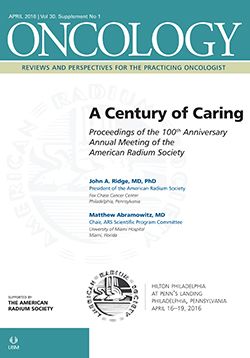(P022) Effectiveness of Intensity-Modulated Radiation Therapy With Simultaneous Integrated Boost in Cervical Cancer Patients With Positron Emission Tomography (PET)-Positive Lymph Nodes
Intensity-modulated radiation therapy with simultaneous integrated boost to PET-positive nodes is well tolerated and provides good local control and OS in node-positive cervical cancer patients.
John W. Shumway, BA, Alfredo E. Echeverria, MD, Umang Patel, MD, Mark D. Bonnen, MD, Michelle S. Ludwig, MD, MPH, PhD; Baylor College of Medicine
PURPOSE: Evaluate the effectiveness of intensity-modulated radiation therapy (IMRT) with simultaneous integrated boost (SIB) in cervical cancer patients with positron emission tomography (PET)-positive lymph nodes. Although it is not a Radiation Therapy Oncology Group–recommended treatment modality, due to overall poor prognosis, we utilize this technology in this class of patients.
MATERIALS AND METHODS: Forty patients with pelvic node–positive cervical cancer (International Federation of Gynecologists and Obstetricians [FIGO] stage IB1–IVB) treated with definitive chemoradiation from 2013–2014 with IMRT were retrospectively analyzed. Patients were treated with IMRT, with the pelvis and uninvolved nodes receiving 1.8 Gy/day to 45–50.4 Gy and the PET-positive nodes treated at 2.07 Gy/day to 51.75–57.96 Gy, depending on bowel tolerance. Patients then received brachytherapy, followed by a boost, to bring positive nodes to 60–66 Gy. Full and empty bladder simulations and cone beam CT were utilized to optimize reproducibility.
RESULTS: Patients had a median of six PET-positive nodes. A total of 17 patients (43%) received full extended-field IMRT for PET-positive para-aortic nodes (up to T12), and 11 patients (28%) received partial extended-field IMRT for PET-positive common iliac nodes (up to L2). With a mean follow-up of 16 months, 15 patients (37%) had recurrent or persistent disease. Sites of recurrent/persistent disease were cervix (6 [15%]), regional nodes (6 [15%]), and distant (10 [26%]). The 2-year overall survival (OS) was 87% (standard error [SE], 0.6), and 2-year progression free survival (PFS) was 63% (SE, 0.9). Treatment was well tolerated; 15 patients (38%) experienced grade 2 gastrointestinal (GI) toxicity, and 1 patient (2%) experienced a grade 3 adverse GI event. With full extended-field IMRT, seven patients (18%) experienced grade 2 adverse GI events vs five patients (13%) with partial extended-field IMRT. Neither group experienced grade 3 adverse GI events.
CONCLUSIONS: IMRT with SIB to PET-positive nodes is well tolerated and provides good local control and OS in node-positive cervical cancer patients.
Proceedings of the 98th Annual Meeting of the American Radium Society - americanradiumsociety.org
